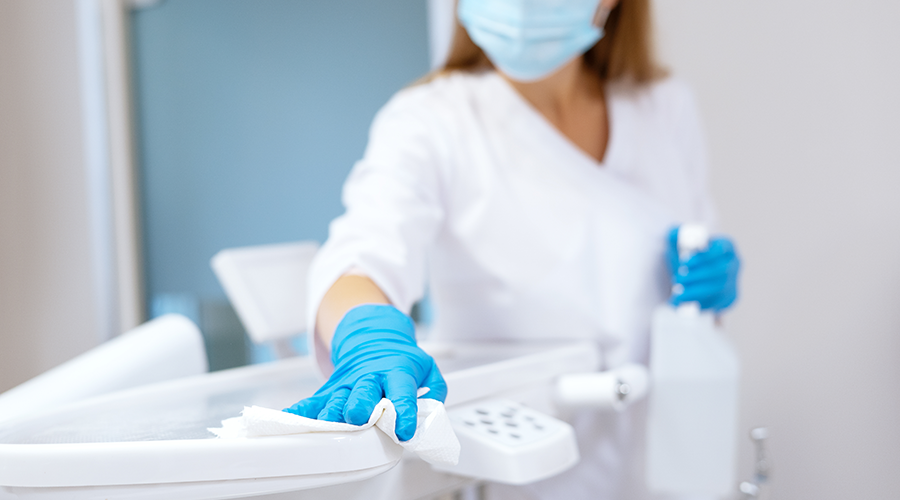It is possible to remove microbes from hard, nonporous surfaces in hospitals and other healthcare facilities with general purpose cleaning products and a micro denier microfiber cloth, but the process will not necessarily kill them. There are numerous examples of contaminated cleaning cloths and equipment actually spreading microbes across surfaces rather than removing them.
Disinfectants are more effective at killing pathogens and bacterial spores, but they tend to be expensive, toxic, corrosive and environmentally unfriendly. Some formulations exist in the water courses underlying towns and cities, and they exert long-term effects on other biological systems.
New methods and products to decontaminate the environment are constantly appearing. Here is a short but fairly representative list of these items:
colorized disinfectants to ensure the proper dwell time and coverage of a surface
- electrostatic sprayers
- microbiocidal gases
- on-demand hypochlorous acid generation from tap water
- Ultraviolet-light-emitting devices
- bioactive surfaces or coatings containing heavy metals or their derivatives
- continuous active disinfectants that last from 24 hours to several days.
Numerous guidelines emphasize the importance of cleaning, but they offer little practical advice on how to achieve this goal or how often sites should receive cleaning attention. Since frequently touched surfaces rapidly become recontaminated, disinfectants and coatings with prolonged biocidal activity might be useful for inhibiting further contamination.
Using agents with residual activity to repel contamination by susceptible pathogens means hand hygiene might not be quite so critical. If such products could be shown to function as promised without significant toxicity, surface cleaning also would become a less important issue by reducing the human variables.
Despite future promise, environmental services departments should not relax or abandon traditional cleaning methods, even if the whole hospital is treated to novel decontamination systems or coated with a bioactive veneer. No single process will remove all relevant microbial soil from hospitals.
Coatings wear off, degrade or simply fail due to the accumulation of organic soil. They also might encourage unforeseen long-term health problems in exposed persons or additional toxic effects on the environment.
These futuristic surfaces might seem appropriate for a 21st Century hospital, but they might offer false assurances if not properly tested in real-world conditions.
All of them require a comprehensive assessment in association with patient outcomes before widespread adoption in healthcare systems. Cash-strapped hospitals should not invest in potentially toxic or expensive coatings without good reason.
It goes without saying that traditional detergent-based cleaning also should receive a full and thorough appraisal. Surprisingly, this has not yet happened.
The guiding principle is always to remove germs if possible rather than kill them and then, when necessary, use the smallest amount of the mildest disinfectant that will kill the microbes in question.
It is possible that simply increasing the cleaning frequency of established, high-risk sites could be a crucial factor in reducing infection risk rather than some toxic alternative. Soap, water, elbow grease and a clear water rinse also cost much less.
J. Darrel Hicks, BA, MESRE, CHESP, Certificate of Mastery in Infection Prevention, is the past president of the Healthcare Surfaces Institute. Hicks is nationally recognized as a subject matter expert in infection prevention and control as it relates to cleaning. He is the owner and principal of Safe, Clean and Disinfected. His enterprise specializes in B2B consulting, webinar presentations, seminars and facility consulting services related to cleaning and disinfection. He can be reached at darrel@darrelhicks.com, or learn more at www.darrelhicks.com.

 Grounding Healthcare Spaces in Hospitality Principles
Grounding Healthcare Spaces in Hospitality Principles UC Davis Health Selects Rudolph and Sletten for Central Utility Plant Expansion
UC Davis Health Selects Rudolph and Sletten for Central Utility Plant Expansion Cape Cod Healthcare Opens Upper 2 Floors of Edwin Barbey Patient Care Pavilion
Cape Cod Healthcare Opens Upper 2 Floors of Edwin Barbey Patient Care Pavilion Building Sustainable Healthcare for an Aging Population
Building Sustainable Healthcare for an Aging Population Froedtert ThedaCare Announces Opening of ThedaCare Medical Center-Oshkosh
Froedtert ThedaCare Announces Opening of ThedaCare Medical Center-Oshkosh